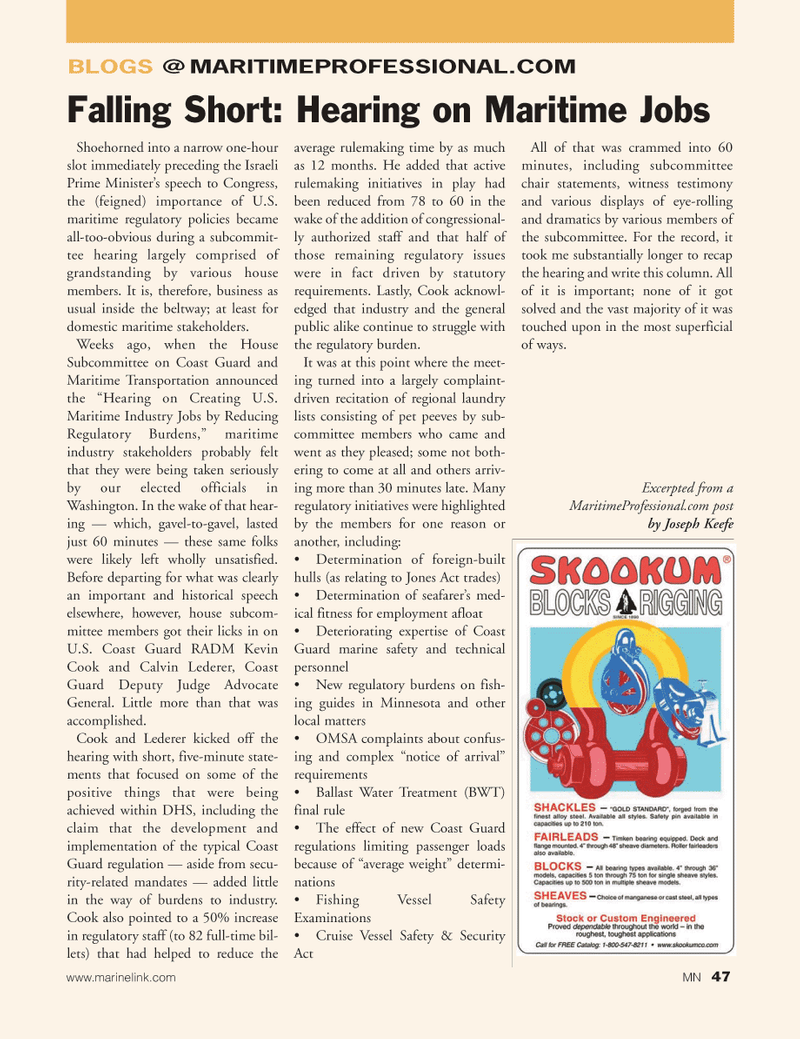
Page 47: of Marine News Magazine (June 2011)
CEO Six-Pack: The Leadership Edition
Read this page in Pdf, Flash or Html5 edition of June 2011 Marine News Magazine
www.marinelink.com MN 47
Shoehorned into a narrow one-hour slot immediately preceding the Israeli
Prime Minister’s speech to Congress, the (feigned) importance of U.S. maritime regulatory policies became all-too-obvious during a subcommit- tee hearing largely comprised of grandstanding by various house members. It is, therefore, business as usual inside the beltway; at least for domestic maritime stakeholders.
Weeks ago, when the House
Subcommittee on Coast Guard and
Maritime Transportation announced the “Hearing on Creating U.S.
Maritime Industry Jobs by Reducing
Regulatory Burdens,” maritime industry stakeholders probably felt that they were being taken seriously by our elected officials in
Washington. In the wake of that hear- ing — which, gavel-to-gavel, lasted just 60 minutes — these same folks were likely left wholly unsatisfied.
Before departing for what was clearly an important and historical speech elsewhere, however, house subcom- mittee members got their licks in on
U.S. Coast Guard RADM Kevin
Cook and Calvin Lederer, Coast
Guard Deputy Judge Advocate
General. Little more than that was accomplished.
Cook and Lederer kicked off the hearing with short, five-minute state- ments that focused on some of the positive things that were being achieved within DHS, including the claim that the development and implementation of the typical Coast
Guard regulation — aside from secu- rity-related mandates — added little in the way of burdens to industry.
Cook also pointed to a 50% increase in regulatory staff (to 82 full-time bil- lets) that had helped to reduce the average rulemaking time by as much as 12 months. He added that active rulemaking initiatives in play had been reduced from 78 to 60 in the wake of the addition of congressional- ly authorized staff and that half of those remaining regulatory issues were in fact driven by statutory requirements. Lastly, Cook acknowl- edged that industry and the general public alike continue to struggle with the regulatory burden.
It was at this point where the meet- ing turned into a largely complaint- driven recitation of regional laundry lists consisting of pet peeves by sub- committee members who came and went as they pleased; some not both- ering to come at all and others arriv- ing more than 30 minutes late. Many regulatory initiatives were highlighted by the members for one reason or another, including: • Determination of foreign-built hulls (as relating to Jones Act trades) • Determination of seafarer’s med- ical fitness for employment afloat • Deteriorating expertise of Coast
Guard marine safety and technical personnel • New regulatory burdens on fish- ing guides in Minnesota and other local matters • OMSA complaints about confus- ing and complex “notice of arrival” requirements • Ballast Water Treatment (BWT) final rule • The effect of new Coast Guard regulations limiting passenger loads because of “average weight” determi- nations • Fishing Vessel Safety
Examinations • Cruise Vessel Safety & Security
Act
All of that was crammed into 60 minutes, including subcommittee chair statements, witness testimony and various displays of eye-rolling and dramatics by various members of the subcommittee. For the record, it took me substantially longer to recap the hearing and write this column. All of it is important; none of it got solved and the vast majority of it was touched upon in the most superficial of ways.
Excerpted from a
MaritimeProfessional.com post by Joseph Keefe
BLOGS @ MARITIMEPROFESSIONAL.COM
Falling Short: Hearing on Maritime Jobs

 46
46

 48
48
